Ghia Road Course Setup
- FJCamper
- Moderator
- Posts: 2910
- Joined: Wed Nov 14, 2007 2:19 pm
Re: Ghia Road Course Setup
Hi 84 IM Flyer;
http://www.eshocks.com/bil_veh.asp?Mode ... &Manf=Koni
Koni Reds & Yellows. For street and light track go red. For track and minimum street go yellow.
We run the old orange Konis, made before the yellows when there was only one!
FJC
http://www.eshocks.com/bil_veh.asp?Mode ... &Manf=Koni
Koni Reds & Yellows. For street and light track go red. For track and minimum street go yellow.
We run the old orange Konis, made before the yellows when there was only one!
FJC
- 84 IM Flier
- Posts: 205
- Joined: Fri May 24, 2002 12:01 am
Re: Ghia Road Course Setup
Thanks for the link
Ron
Ron
- superstar
- Posts: 174
- Joined: Sat Nov 07, 2009 8:03 pm
Re: Ghia Road Course Setup
FJCamper,
When do we hear about wheels?
When do we hear about wheels?
- FJCamper
- Moderator
- Posts: 2910
- Joined: Wed Nov 14, 2007 2:19 pm
Re: Ghia Road Course Setup
Hi Superstar,
Here we go---
FJC
Here we go---
FJC
Last edited by FJCamper on Thu Dec 17, 2009 11:51 am, edited 1 time in total.
- FJCamper
- Moderator
- Posts: 2910
- Joined: Wed Nov 14, 2007 2:19 pm
Re: Ghia Road Course Setup

RetroRacing's 53 has used both steel and alloy wheels. Here, at Road Atlanta, we ran the eight-spoke EMPI style aluminum alloy wheel. The ones shown are actually sold by American Eagle. 15x5.5" with 4" backspace.
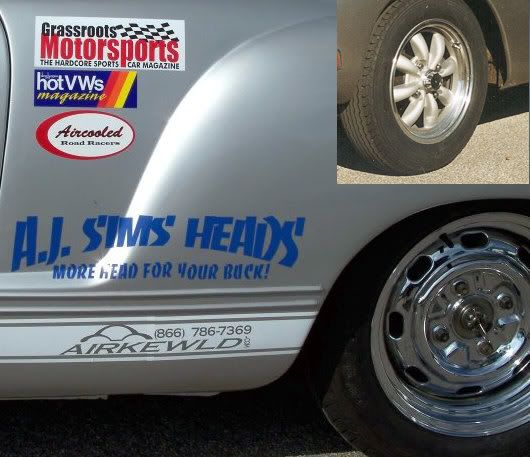
Above: Our 261 Carrera Panamericana car ran traditional steel "disk" wheels. EMPI 8-spoke style wheel inset for comparison. The steel wheels here are original Mangle, 15x5.5" with 4.75" backspace.
Wheels are perhaps the most popular "looks" item on cars, but here we're talking about functionality for high performance duty.
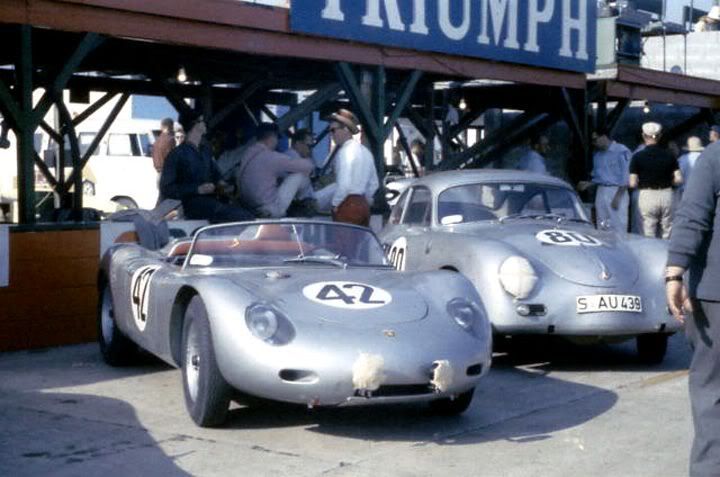
Original VW's and Porsches came with steel wheels, and had them when wire wheels were still considered mandatory sporty car equipment. The steel "disk wheel" was a leap ahead of the wire wheel technologically. They didn't flex like wire wheels, tended to stay round and true, and cost less.
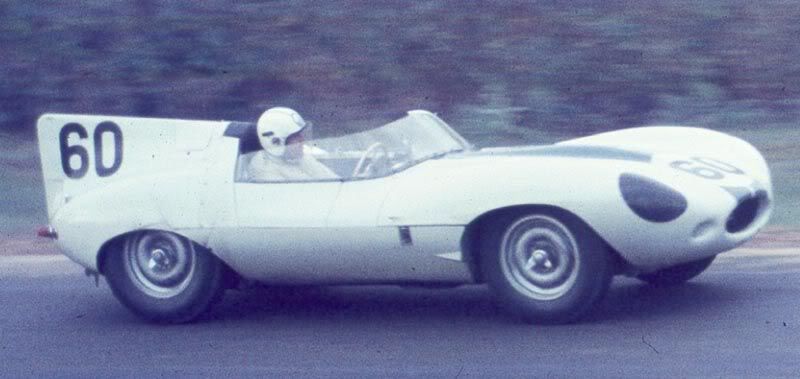
Above: 1957. A D-Jaguar runs steel disk wheels, giving up on the traditional (and sexier) British wire wheels for better handling.
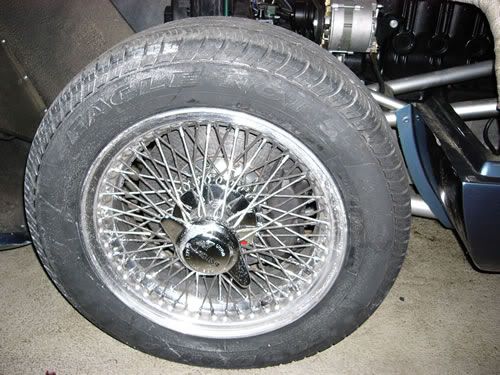
The C-Jags ran on wire spoke wheels.
World War II brought about the widespread use of structural, lightweight magnesium parts, especially in aircraft. And the automotive and racing world took advantage of the new technology where it could. Obviously, the VW, with its magnesium alloy engine and transmission cases were ahead of the tech curve.
The disk brake and magnesium wheels were aircraft developments that fit right into automotive competition use. The problem with magnesium aircraft wheels was fire. A real mag wheel burns in an absolutely spectacular way at 2,500 °F. Tire blowouts on landing sometimes made that happen. Early experiments in machined mag castings for Formula cars got mag wheels banned in the UK for some racing classes.
Aluminum-magnesium alloy wheels were stronger than magnesium itself and provided far less drama if scraped along the road. American Racing Equipment introduced alloy "mag" racing wheels for dragsters in 1960, and like they say, the rest is history.
We still call magnesium-aluminum, and even just aluminum wheels "mags" today. Old habits die hard. In this article, we'll call them alloy wheels.
It is a misconception that alloy wheels are always lighter than steel wheels of the same size. Sometimes they're lighter, sometimes the same weight, sometimes even heavier. But weight is not all it's about.
An alloy wheel is made from a machined casting, and is usually true round. The alloy, bolted directly to the brake, is a far better conductor of heat than steel (a big racing advantage), and the alloy wheel is safer overall because it does not flex like steel.
The small-bolt diameter typical in steel wheels sometimes causes the wheel rim to break away from its own center. The wheel center will still be bolted to the brake disk or drum while the rim and tire is bouncing down the track!
It was the wide-five bolt pattern VW and Porsche used on its steel wheels that allowed the Porsche 356 and 550 Spyders to keep using them in racing when the competition had already begun to switch to alloys.
In defense of steel wheels, center failure is not common, and the 4.75" backspace of the 15x5.5" Mangle wheels allows wider tires than stock.
If you're running steel wheels, remember to retorque the bolts or lug nuts between practice sessions or races. They will loosen up.
On the subject of bolts or lug nuts & studs, VW and Porsche went for bolts because the wheel slightly "centers" better on a brake with bolts (and therefore rolls truer) than with studs. But studs win out for ease of use, explaining why Porsche eventually went to studs.
UNSPRUNG WEIGHT (again)
Lighter wheels reduce unsprung weight, allowing the suspension to follow the road surface (less bounce) more closely with better grip.
STEEL vs ALLOY REPAIRS
If damaged from a pothole or curb impact, alloy wheels are harder to repair than steel wheels, and certainly cost more to replace. Alloy material can bend, but typically chips or cracks.
THE IMPORTANCE OF BACKSPACE
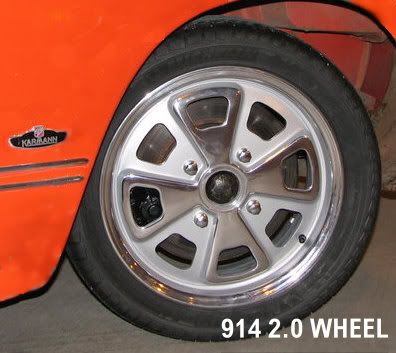
Above: The 914 2.0 liter Fuchs wheel in 15x5.5" gives 4.4" of backspace and allows larger tires to be mounted to the Karmann Ghia. MidAmerica Motorworks sells a replica of this wheel (part No. 370-609) but advises that it is not for disk brakes (!) as the wheel strikes or rubs the caliper.
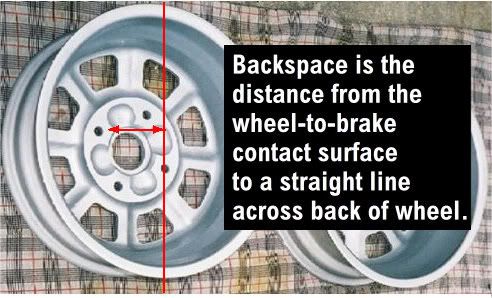
Above: Backspace measurement on a 914 2.0 style wheel.
Backspace tells you how "deep" the wheel sits in the wheel well when bolted to the brake. Generally speaking, the more the backspace, the wider the tire you can fit in a tight area like a Ghia's rear wheel well.
SPACERS & LUG NUTS/BOLTS
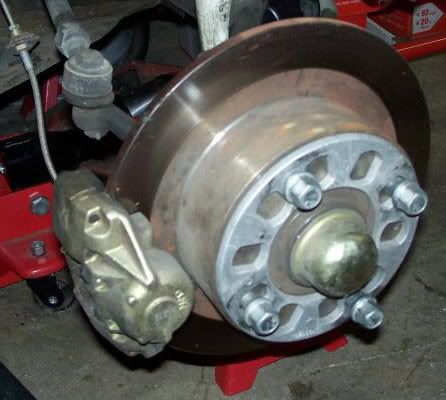
Above: 4x130mm bolt pattern (VW and 914 four-lug) spacer in 1/4" thickness shown.
Performance Products http://www.automotion.com sells a good selection of wheel spacers for VW's and Porsches, to include wide-five spacers. The purpose of a spacer is to set the wheel away from the brake (side effect of decreasing backspace) and moving the outer edge of the tire closer to the fender lip.
Spacers can be used to slightly increase track, to move the wheel outward to cosmetically better fill the wheel well, or to space the wheel away from the brake to help clear a caliper.
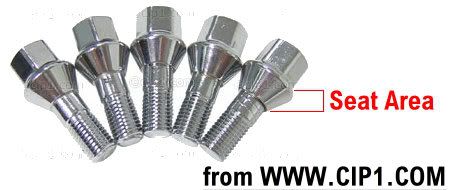
Be sure the seating area on your lug nuts or bolts has the right taper to fit your wheel! Note that there are shallow and deep tapers. Most alloy wheels use the deep taper.
WHEEL ADAPTERS
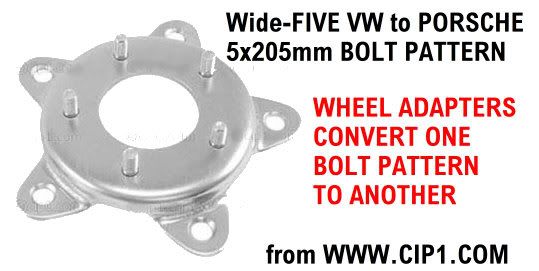
Above: Adapters won't get past most race track tech inspections. Wheel adapters are for the street, not racing.
Wheel adapters have long been part of the VW modifiers bag of tricks, and overall, are handy items. But for racing, don't use them. The faster you go and the more loads you place on your wheels, the less trickery you want. Some Porsche purists even hesitate to use wheel spacers because of the longer bolts necessary ... and we know the story of the buggy guy that ran VW-to-Chevy adapters and won the Sandtrap 150 or whatever ... that was his neck. Be more careful with yours.
WHEELS, SPEED & SAFETY
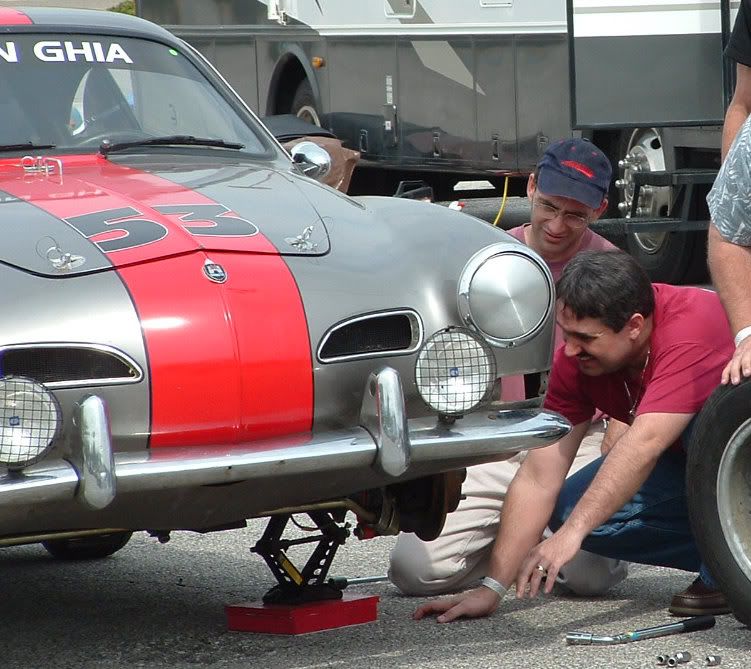
Above: The RetroRacing crew inspects between sessions.
When you fit a set of wheels and tires, you have to constantly watch them for proper lug nut torque, rubbing both in steering and full up-and-down suspension movement. And out-of-round conditions. And wheel cracks! Make safety inspections routine.
It goes without saying that wheels and tires should be accurately balanced. You can balance a racing tire with a simple bubble balance device, because racing tires require more frequent balancing as they wear. Spin-balance machines are nice for street cars and give you a better balance because the mass of the brake is taken into consideration, but walk over to the Goodyear trailer at the track and see what they're using to balance their tires. Bubble balancers.
...AND IN CONCLUSION
Wire wheels are for looks.
Steel wheels are better than wire and good for racing.
Alloy wheels are the best overall.
This post concludes the Ghia Road Course series.
FJC
- superstar
- Posts: 174
- Joined: Sat Nov 07, 2009 8:03 pm
Re: Ghia Road Course Setup
FJCamper,
Thank you very much for your time in this series of excellent posts. You have given me the knowledge and confidence I needed to properly set up my ghia for the track.
Thank you very much for your time in this series of excellent posts. You have given me the knowledge and confidence I needed to properly set up my ghia for the track.
- DORIGTT
- Posts: 614
- Joined: Thu May 18, 2000 12:01 am
Re: Ghia Road Course Setup
Now you need a post on driver education!
I've seen quite a few 'Johnny-Racers' take great information like this and from the other forums to make their cars faster, but then run out of skill and real estate at the same time.
I've seen quite a few 'Johnny-Racers' take great information like this and from the other forums to make their cars faster, but then run out of skill and real estate at the same time.
- FJCamper
- Moderator
- Posts: 2910
- Joined: Wed Nov 14, 2007 2:19 pm
Re: Ghia Road Course Setup
Hi DORIGTT,
You are so right. Why not?
My qualifications are that I realized early on I wasn't the fastest driver and went on to wrenching and crew chiefing for those who could win, and did it through many regional and national championships.
It'll have to be prefaced as an opinon piece, but maybe it'll keep a VW or two on the road, rightside up.
FJC
You are so right. Why not?
My qualifications are that I realized early on I wasn't the fastest driver and went on to wrenching and crew chiefing for those who could win, and did it through many regional and national championships.
It'll have to be prefaced as an opinon piece, but maybe it'll keep a VW or two on the road, rightside up.
FJC
- DORIGTT
- Posts: 614
- Joined: Thu May 18, 2000 12:01 am
Re: Ghia Road Course Setup
One of the finest things I've ever heard was 'I've run that track on Forza 2 Motorsport. It ain't that tough'
I thought wow...getting the fastest time on Mario superKart doesn't make you a wiz with the wheel. I'm in the auto industry and I hear participants in my classes bragging about how good they are all the time. I remarked that if 'some people' were half as good as they make it sound, then they'd have a contract driving something that's faster than their Yugo GTV. The stupidity usually stops then.
I thought wow...getting the fastest time on Mario superKart doesn't make you a wiz with the wheel. I'm in the auto industry and I hear participants in my classes bragging about how good they are all the time. I remarked that if 'some people' were half as good as they make it sound, then they'd have a contract driving something that's faster than their Yugo GTV. The stupidity usually stops then.
-
kdf
- Posts: 110
- Joined: Fri Jun 03, 2005 5:37 am
Re: Ghia Road Course Setup
I've been involved with driver training a bit during the past two years. I've learned that time spent driving on a race track doesn't mean you get faster, you need a game plan to speed up the learning process. The game plan is personal, with number 1 priority on keeping the car alive. Locking brakes, overrevving, oversteer in fast corners, these all will come back and bite you if you don't correct it. The driver isn't aware of everything that happens, so he might not notice it. If a problem is car-related, then it needs to be fixed, but it's usually the drivers fault if the car is regularly maintained and kept in good shape.DORIGTT wrote:Now you need a post on driver education!
I've seen quite a few 'Johnny-Racers' take great information like this and from the other forums to make their cars faster, but then run out of skill and real estate at the same time.
The number one skill a driver develops is "traction sensing". It's the ability to feel how much grip the tires are producing. People who have a good feel for how to get the most of the car are usually naturally fast. Second to this comes consistency. The ability to drive the same lap time in a longer run. This is about how to find the brake and turn-in points lap after lap. When you have feel for the car and consistency, you can start improving driving lines and the car set-up. A driver that is a fast learner in the beginning might have it very difficult to progress once he has gotten up to some speed. It's easier to start with a "blank" driver.
When the driver improves you will run into new problems. They will need to be pointed out early on before they become habits. A bad habit will need a long time to cure, the driver needs to be made aware of it and reminded and the rest will be taken care of by it's own. You will need people around you that give quality input about your driving. These people are the most helpful when you "get stuck" with your driving and need some pointers how to move forwards.
I've had data loggers to rely on when working with drivers, but I'm not sure how many over here have one in their race car. Even though the prices of data loggers have dropped, they are still expensive.
- FJCamper
- Moderator
- Posts: 2910
- Joined: Wed Nov 14, 2007 2:19 pm
Re: Ghia Road Course Setup
Hi KDF,
Very perceptive post, sir.
My approach to this "driver education" series will be from the owner/sponsor & crew chief perspective, a combo of training the driver, building the crew & team, and winning, winning, winning.
There are lots of good books on how to drive fast, directed at the driver. This is to be about how to drive fast, as driver and car development goes forward.
FJC
Very perceptive post, sir.
My approach to this "driver education" series will be from the owner/sponsor & crew chief perspective, a combo of training the driver, building the crew & team, and winning, winning, winning.
There are lots of good books on how to drive fast, directed at the driver. This is to be about how to drive fast, as driver and car development goes forward.
FJC
- petew
- Posts: 3920
- Joined: Sat Oct 07, 2006 4:05 pm
Re: Ghia Road Course Setup
I've just found this thread. what an awesome font of knowledge you given us. thanx heaps! 
just a quick qu. how much bump and droop are you running on your track and road cars?
just a quick qu. how much bump and droop are you running on your track and road cars?
- FJCamper
- Moderator
- Posts: 2910
- Joined: Wed Nov 14, 2007 2:19 pm
Re: Ghia Road Course Setup
Hi PeteW,
By "bump," if you mean bump steer, we run stock settings as we are only lowered two inches (is this this droop you ask about?) on 53 via our Puma axle.
261 is at stock ride height as it has to deal with real-world Mexican roads.
If I've misunderstood your terms, let me know.
FJC
By "bump," if you mean bump steer, we run stock settings as we are only lowered two inches (is this this droop you ask about?) on 53 via our Puma axle.
261 is at stock ride height as it has to deal with real-world Mexican roads.
If I've misunderstood your terms, let me know.
FJC
- 84 IM Flier
- Posts: 205
- Joined: Fri May 24, 2002 12:01 am
Re: Ghia Road Course Setup
Unfortunately, I haven't had any luck finding a front and rear set of Koni reds. Seems they're no long made. I tried FJC's link and went to another site Koni site that advertised Koni shocks for a 1970 beetle. Both could not longer get the shocks for me. These companies have the shocks listed on their sites, but when they try to order them....nothing.
So, I'm back to looking for a decent shock.
Bilsteins are available, but I have no idea how they compare to the Konis.
I've come across coilovers for offroad VWs, but does anyone make a set of coilovers for the the street?
Shocks are going in my 1984 Intermeccanica 356 replica (pan), and I'm trying to set the car up to be a canyon carver, with a little autoX on the side.
Thanks
Ron
So, I'm back to looking for a decent shock.
Bilsteins are available, but I have no idea how they compare to the Konis.
I've come across coilovers for offroad VWs, but does anyone make a set of coilovers for the the street?
Shocks are going in my 1984 Intermeccanica 356 replica (pan), and I'm trying to set the car up to be a canyon carver, with a little autoX on the side.
Thanks
Ron
- FJCamper
- Moderator
- Posts: 2910
- Joined: Wed Nov 14, 2007 2:19 pm
Re: Ghia Road Course Setup
Hi Ron,
Sorry about the Konis.
A good compromise shock for street use is the KYB GR2.
FJC
Sorry about the Konis.
A good compromise shock for street use is the KYB GR2.
FJC